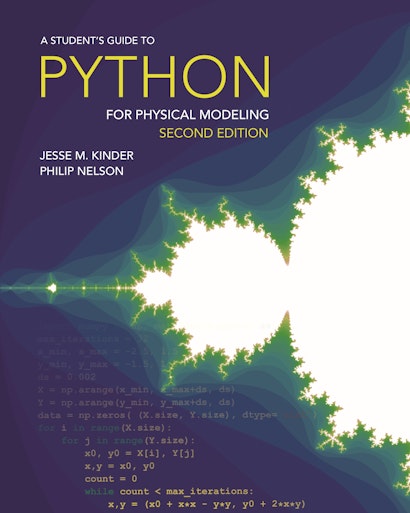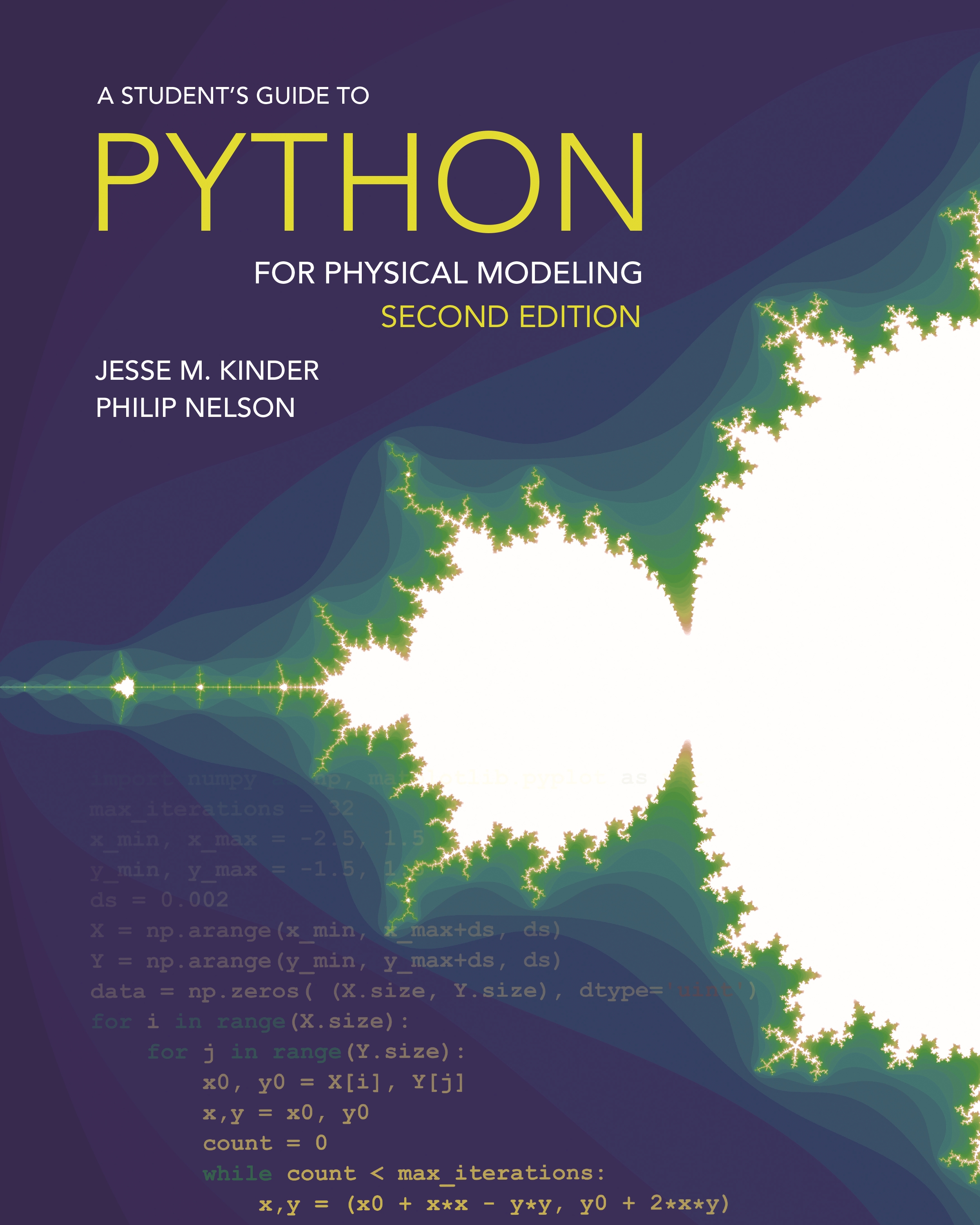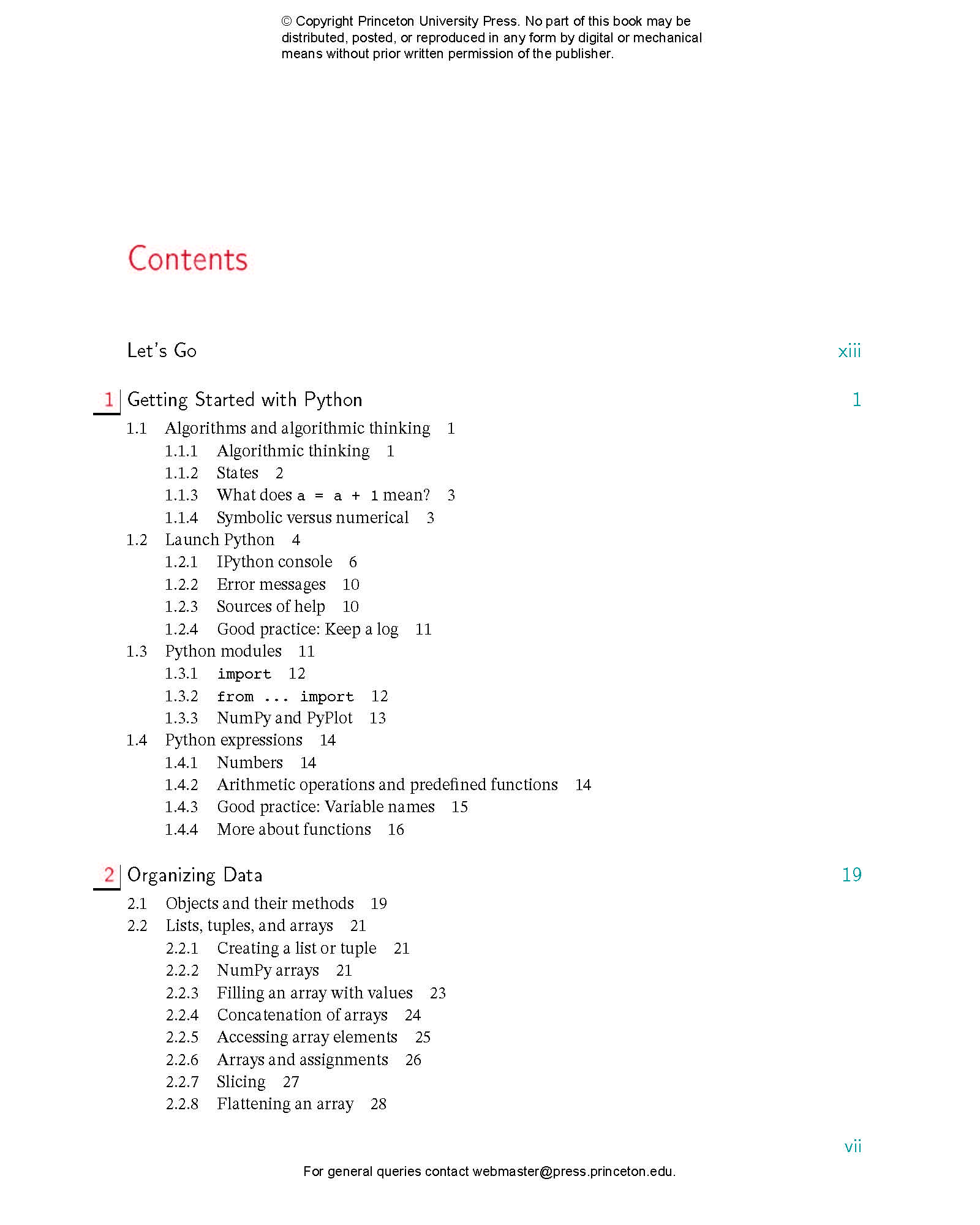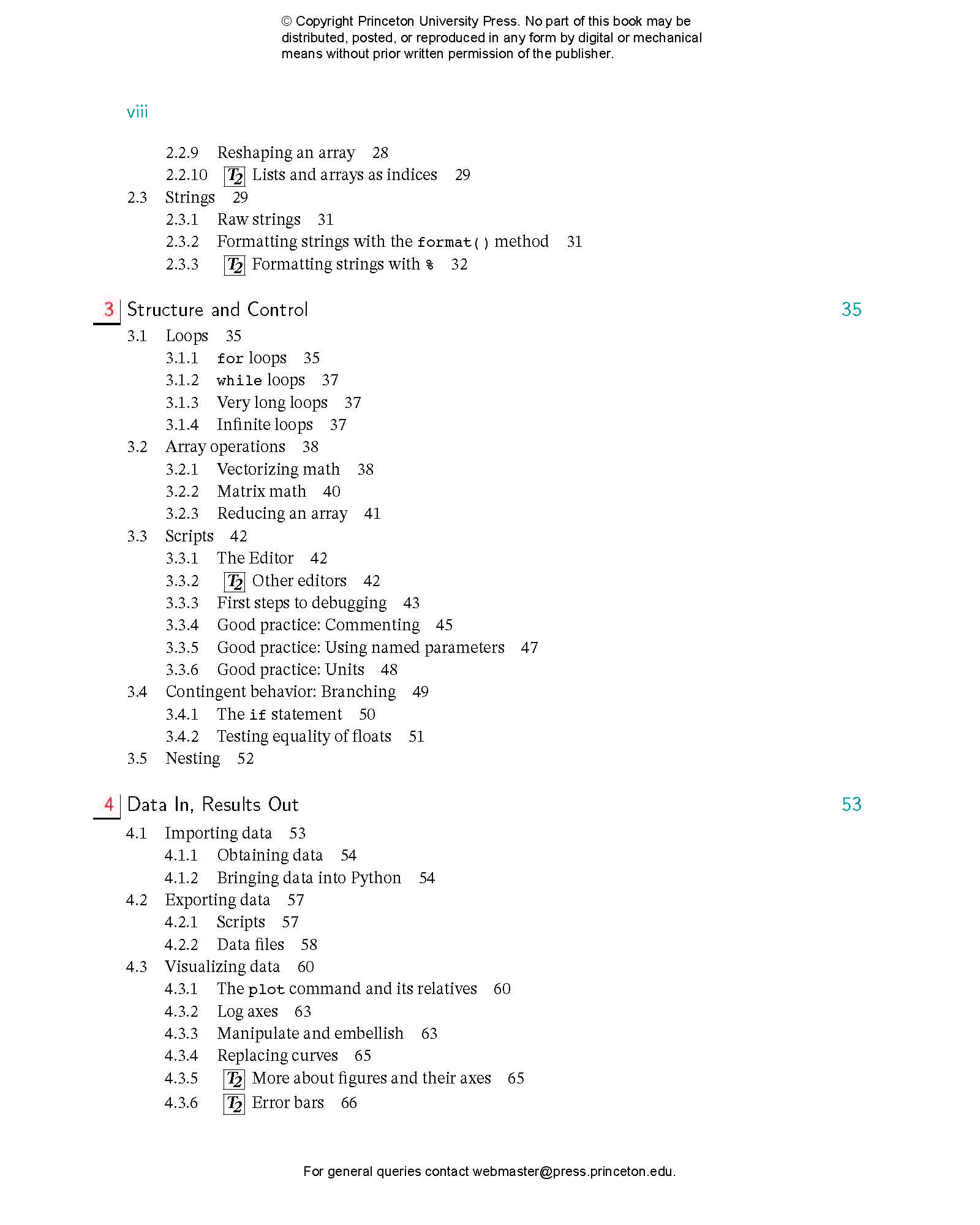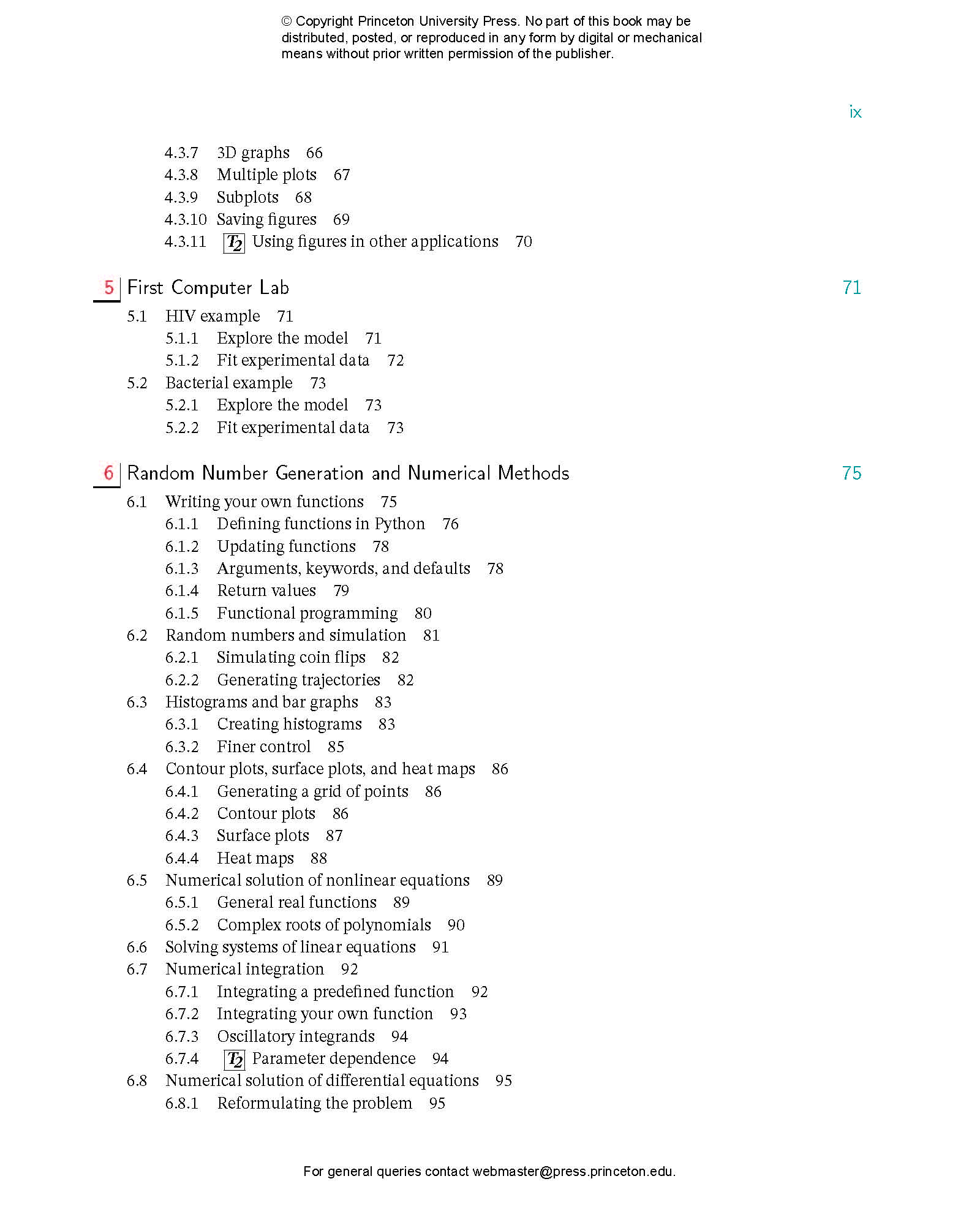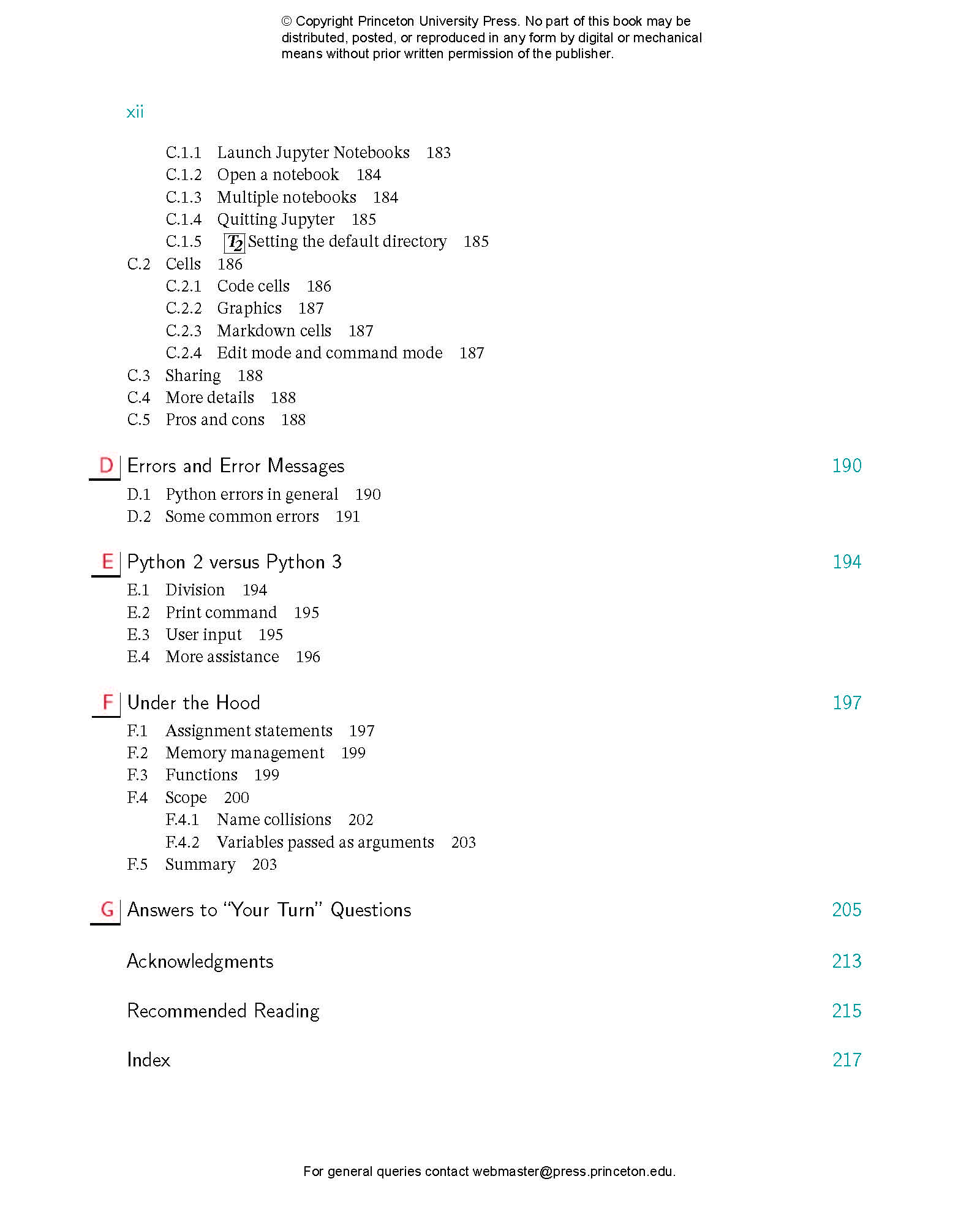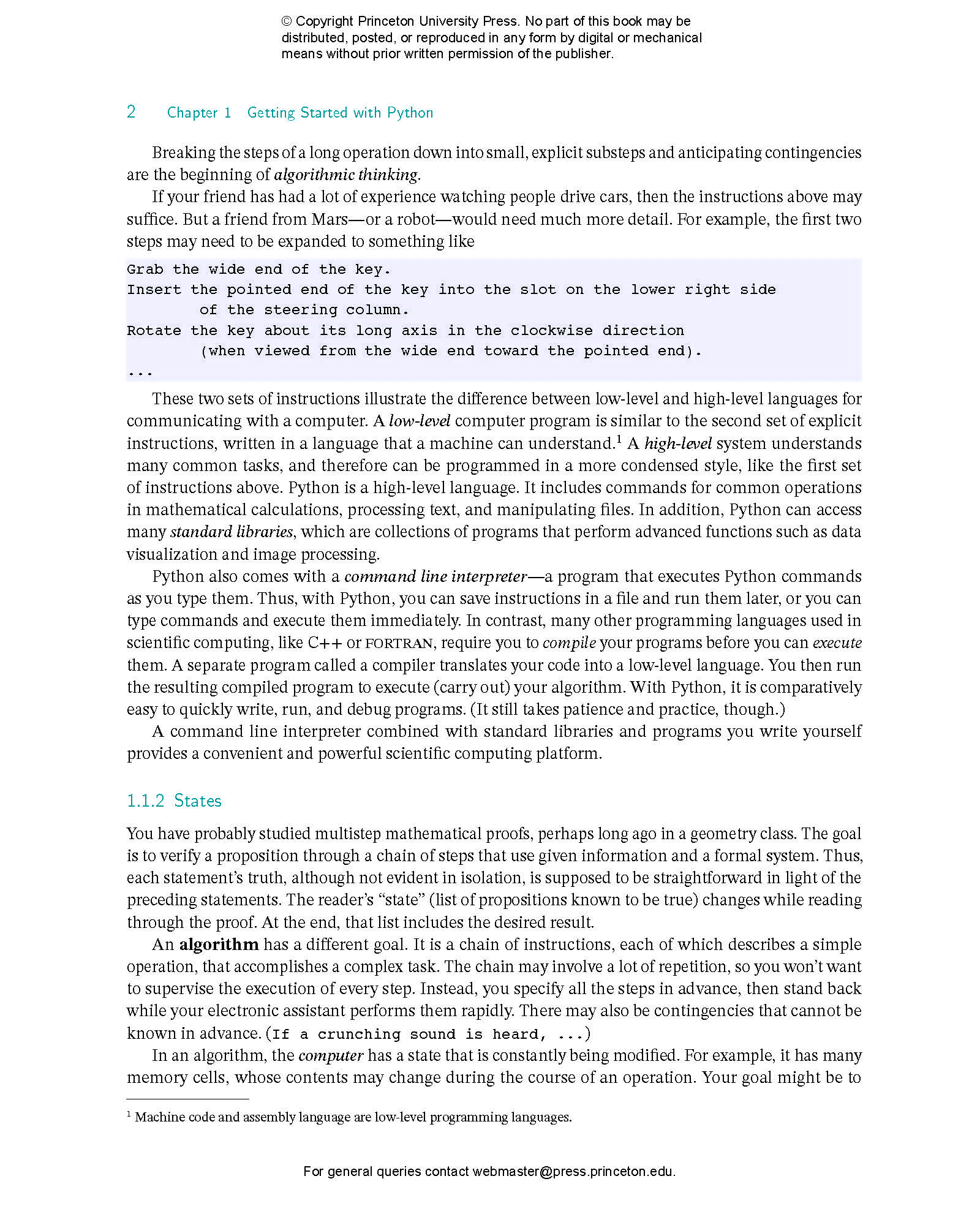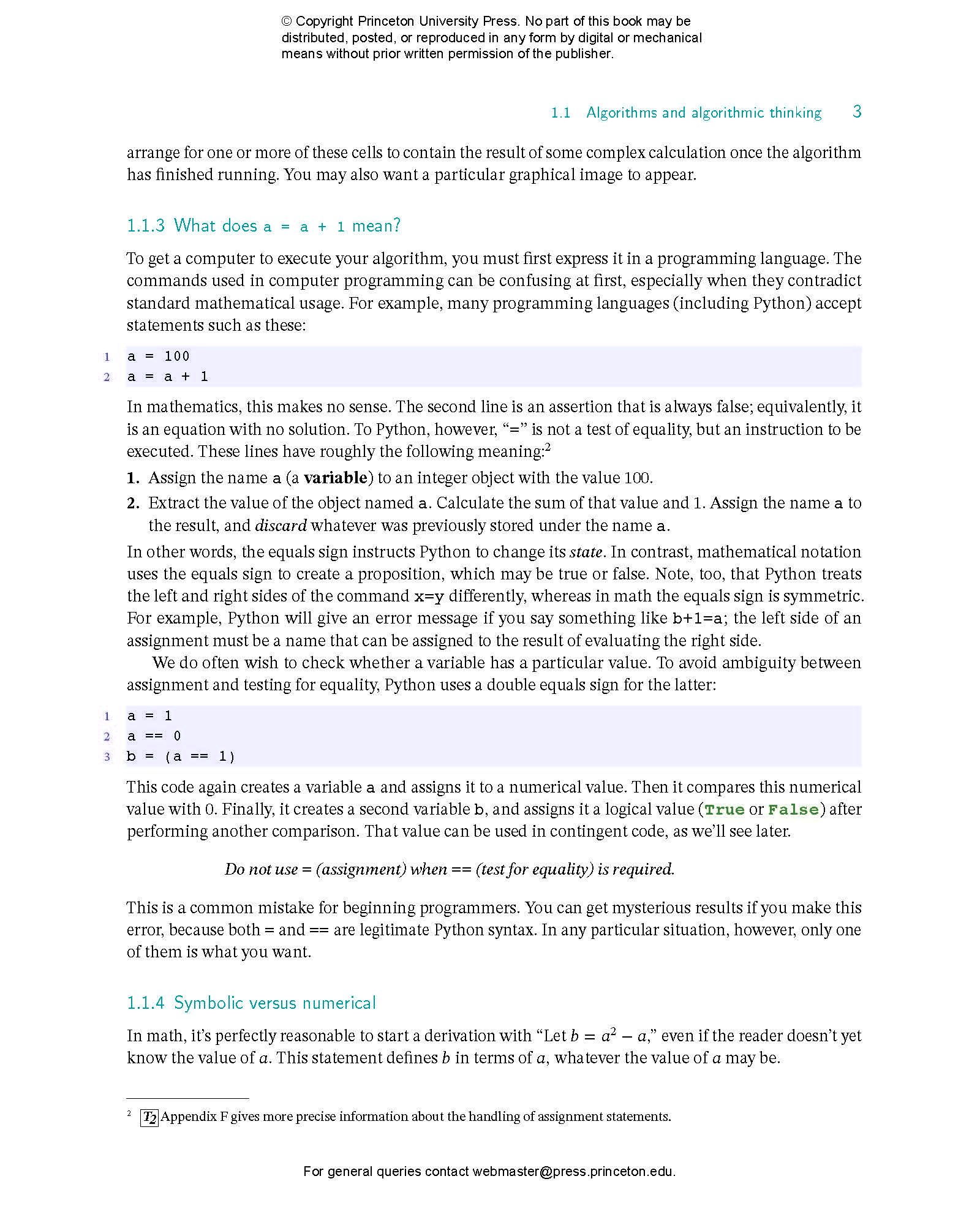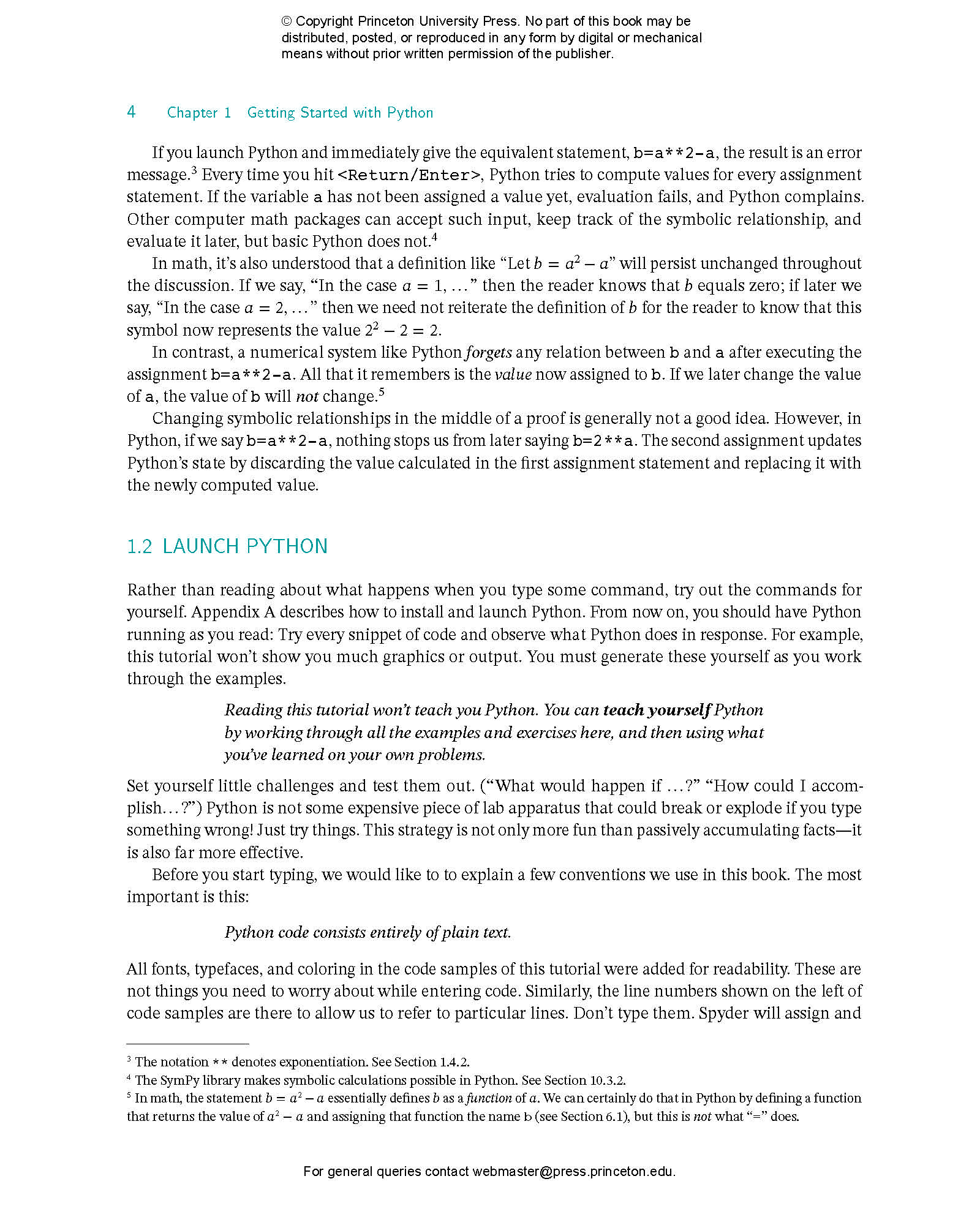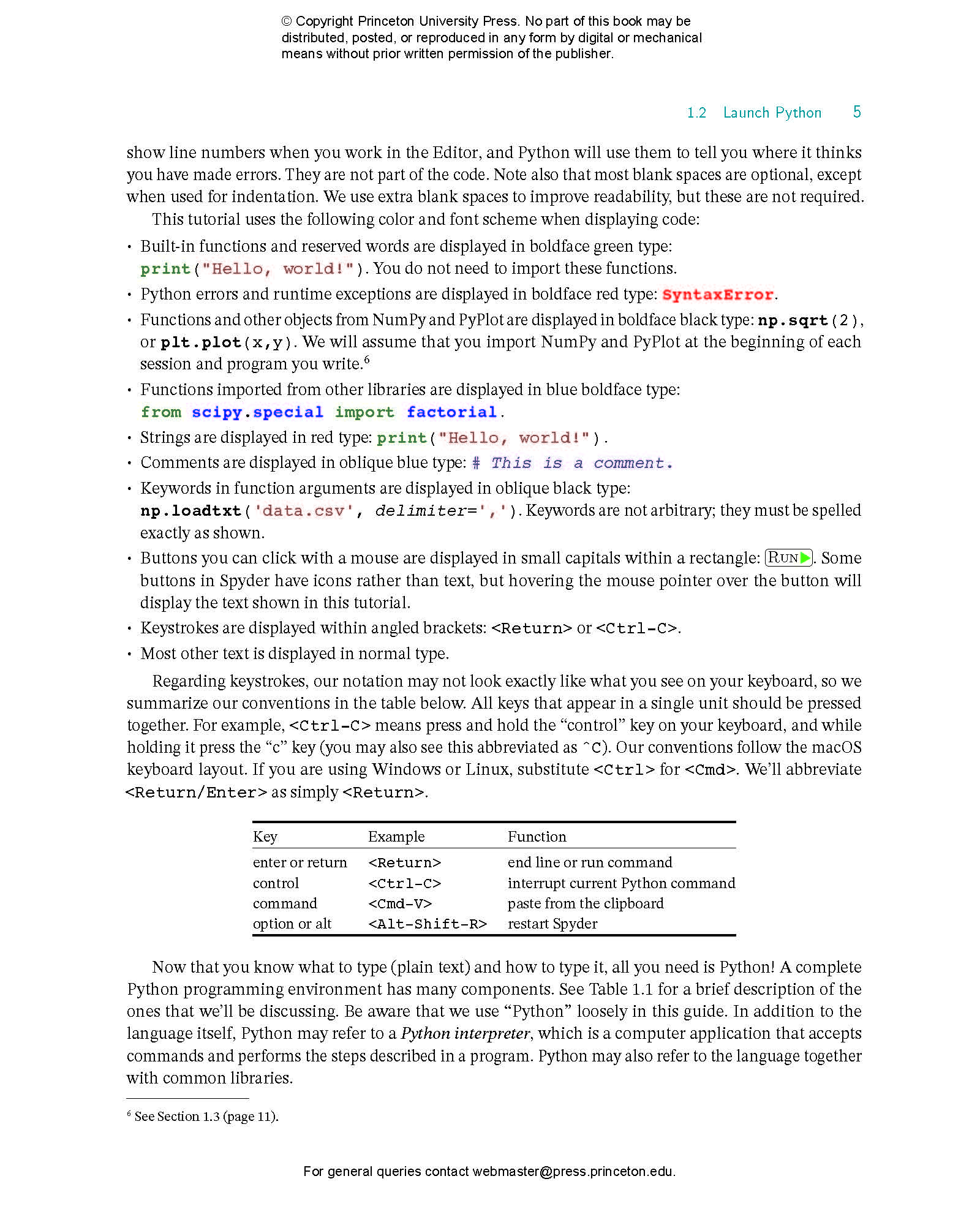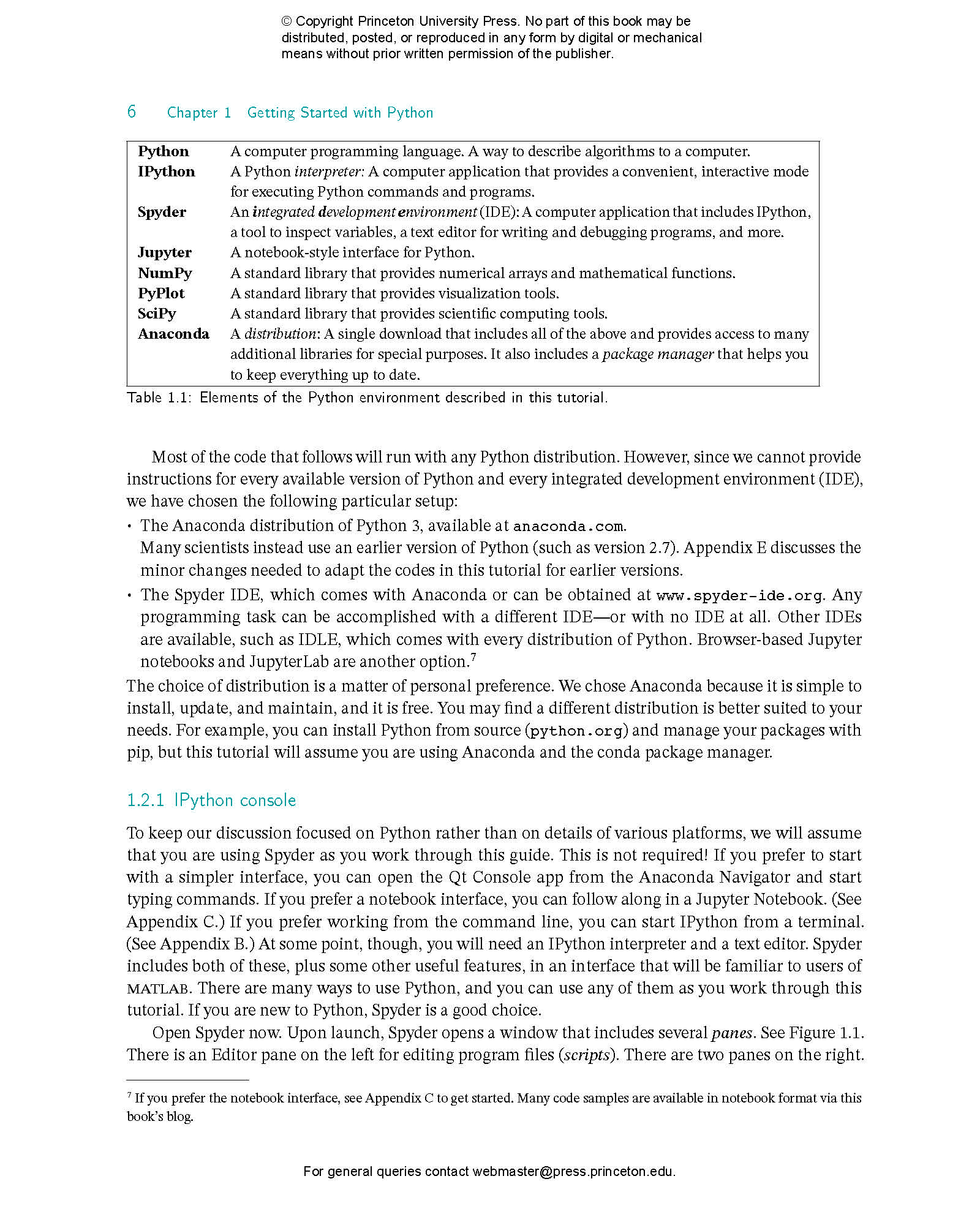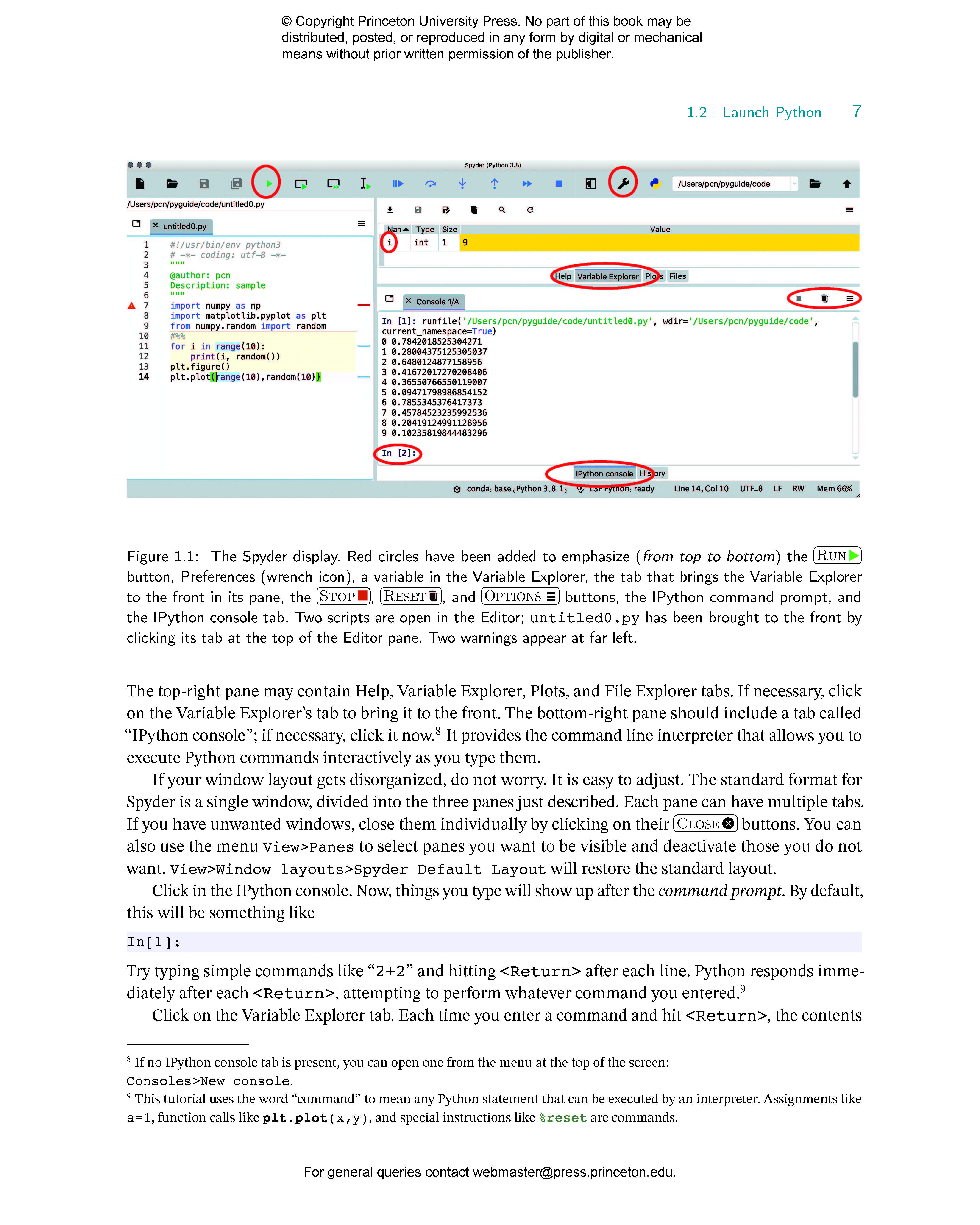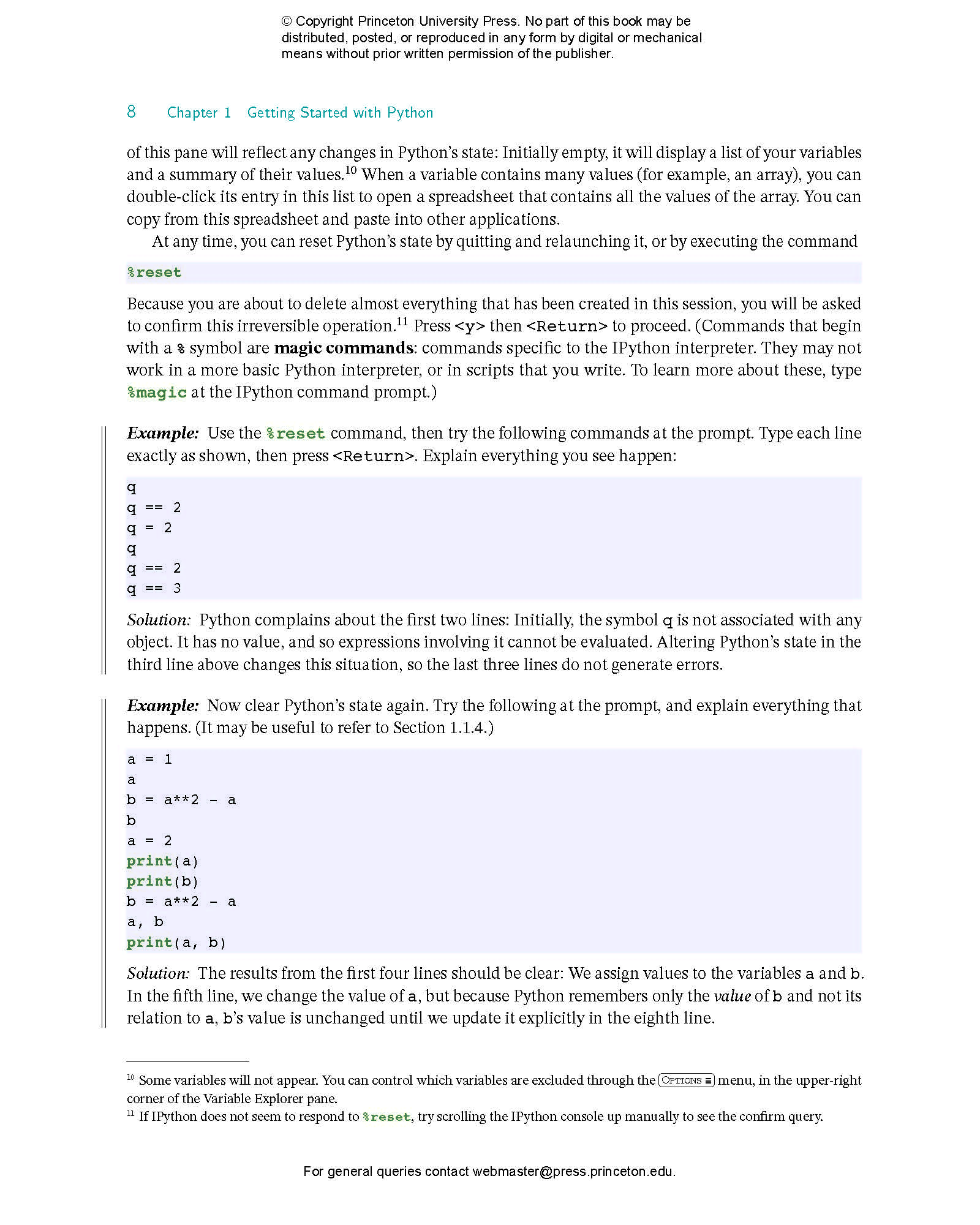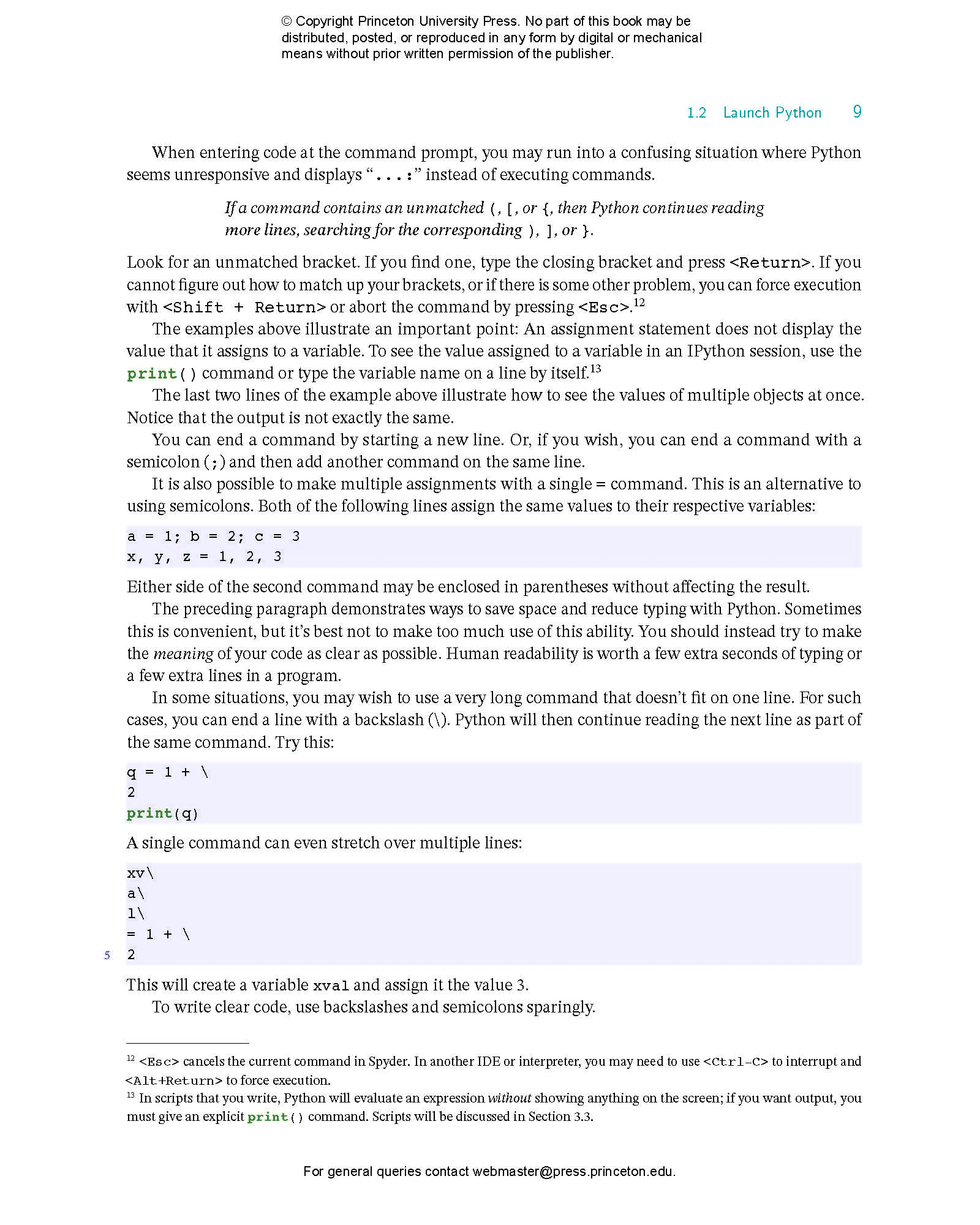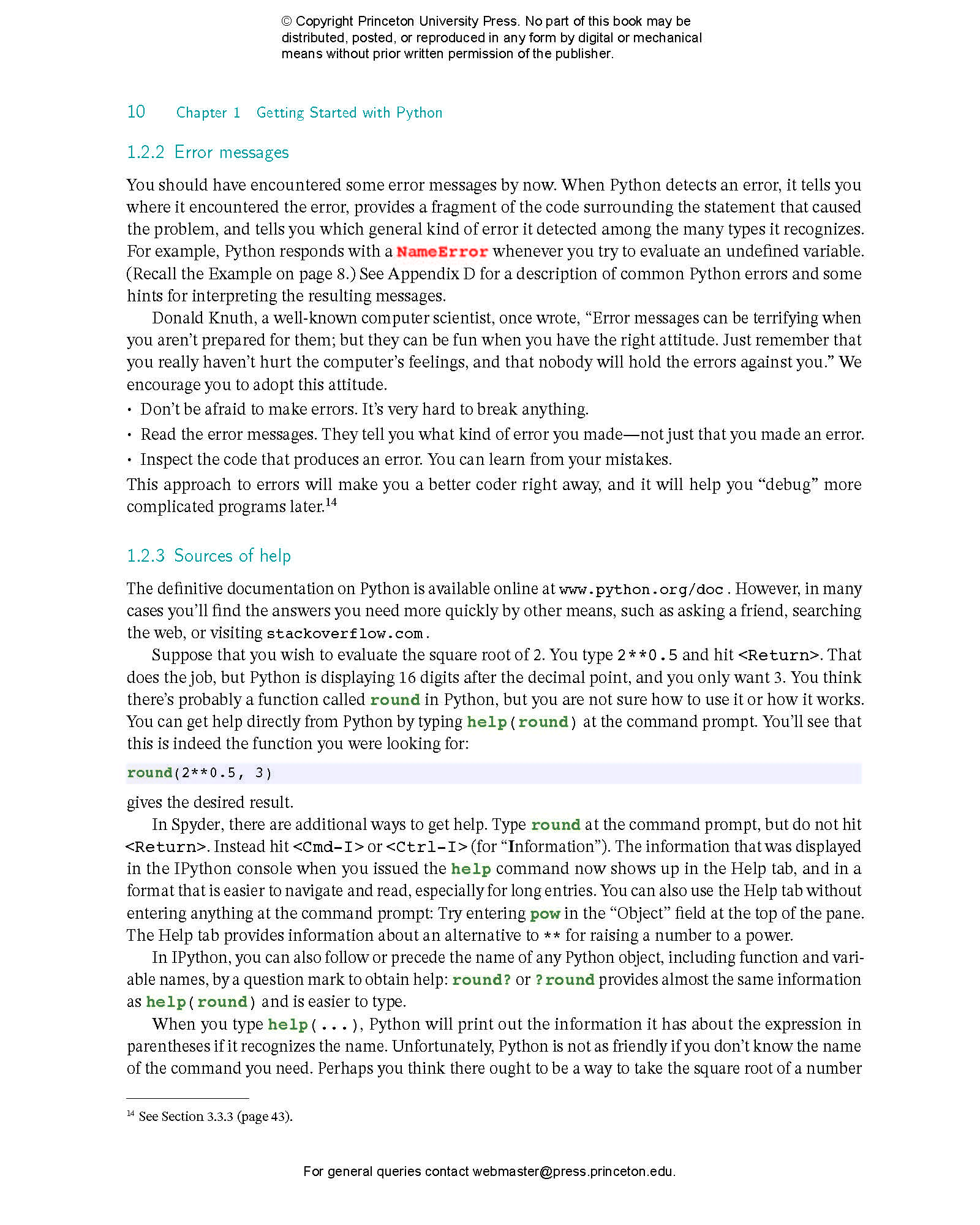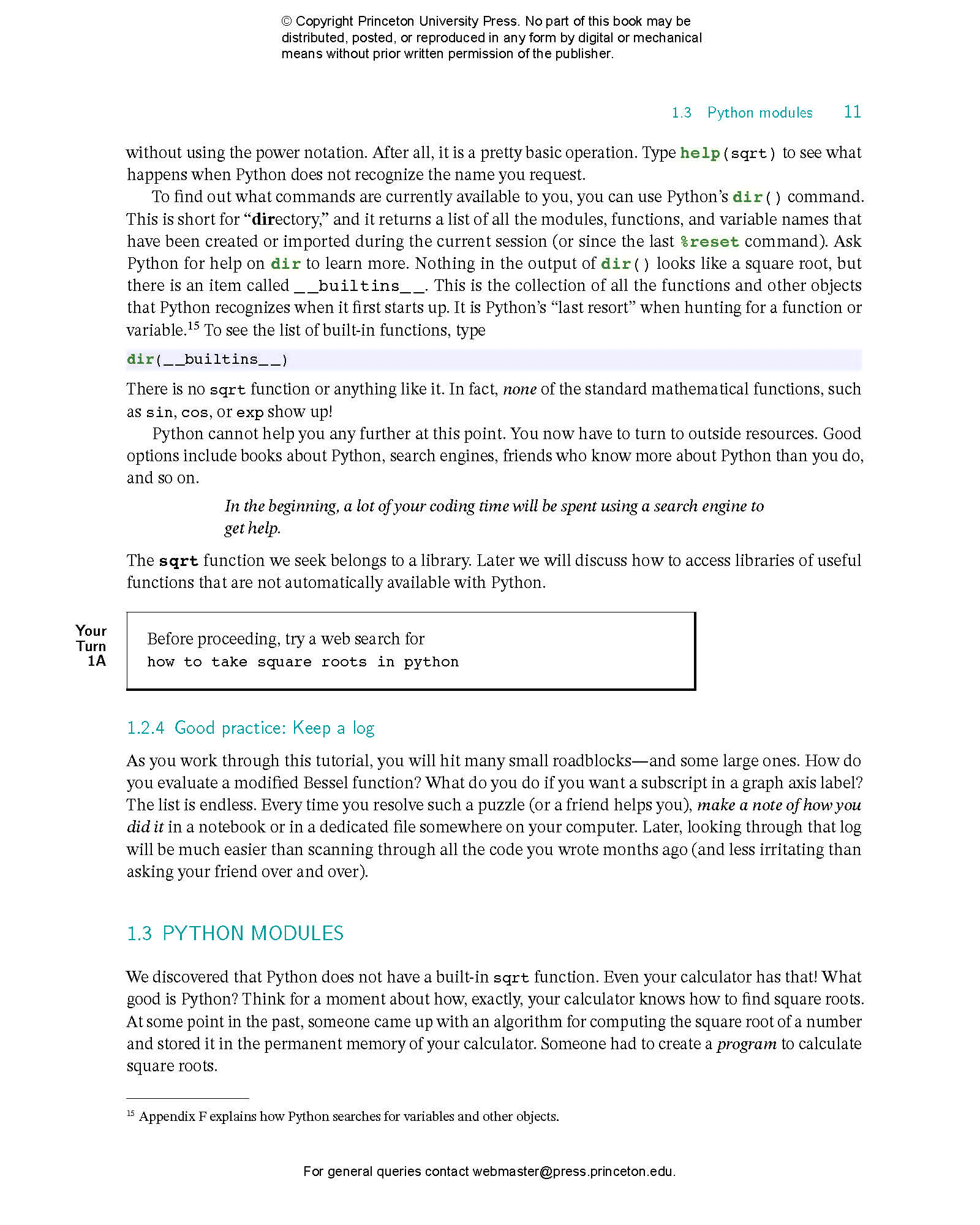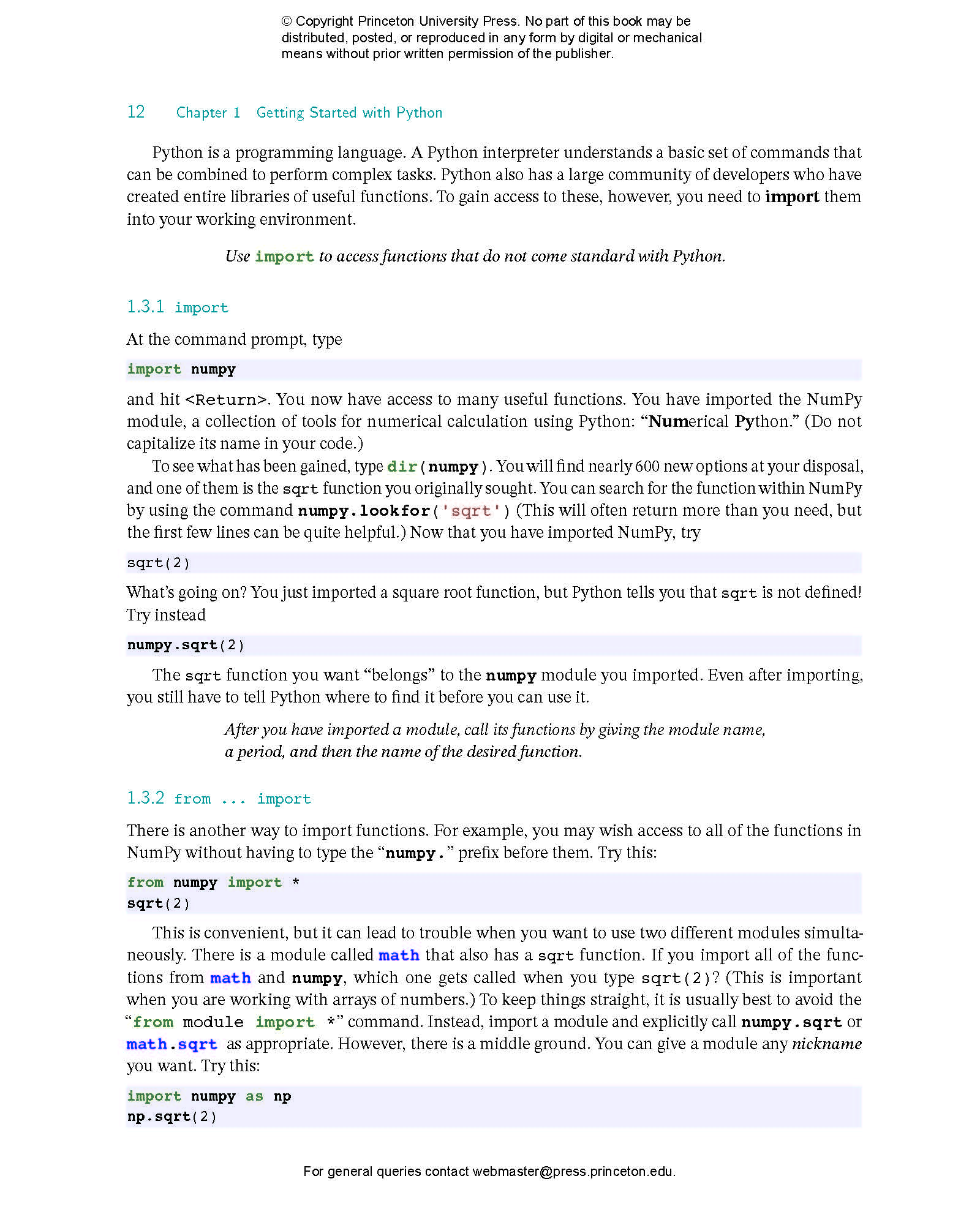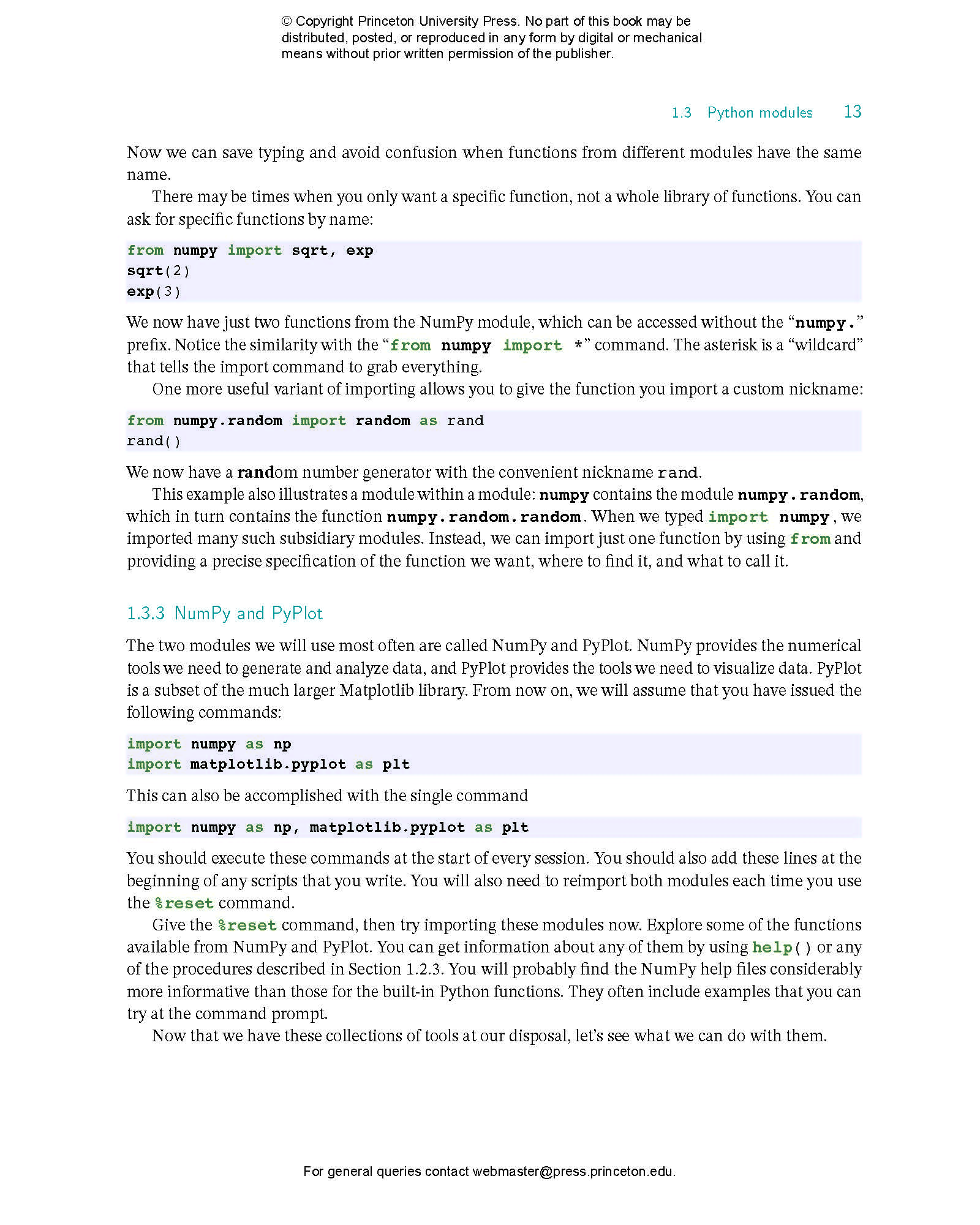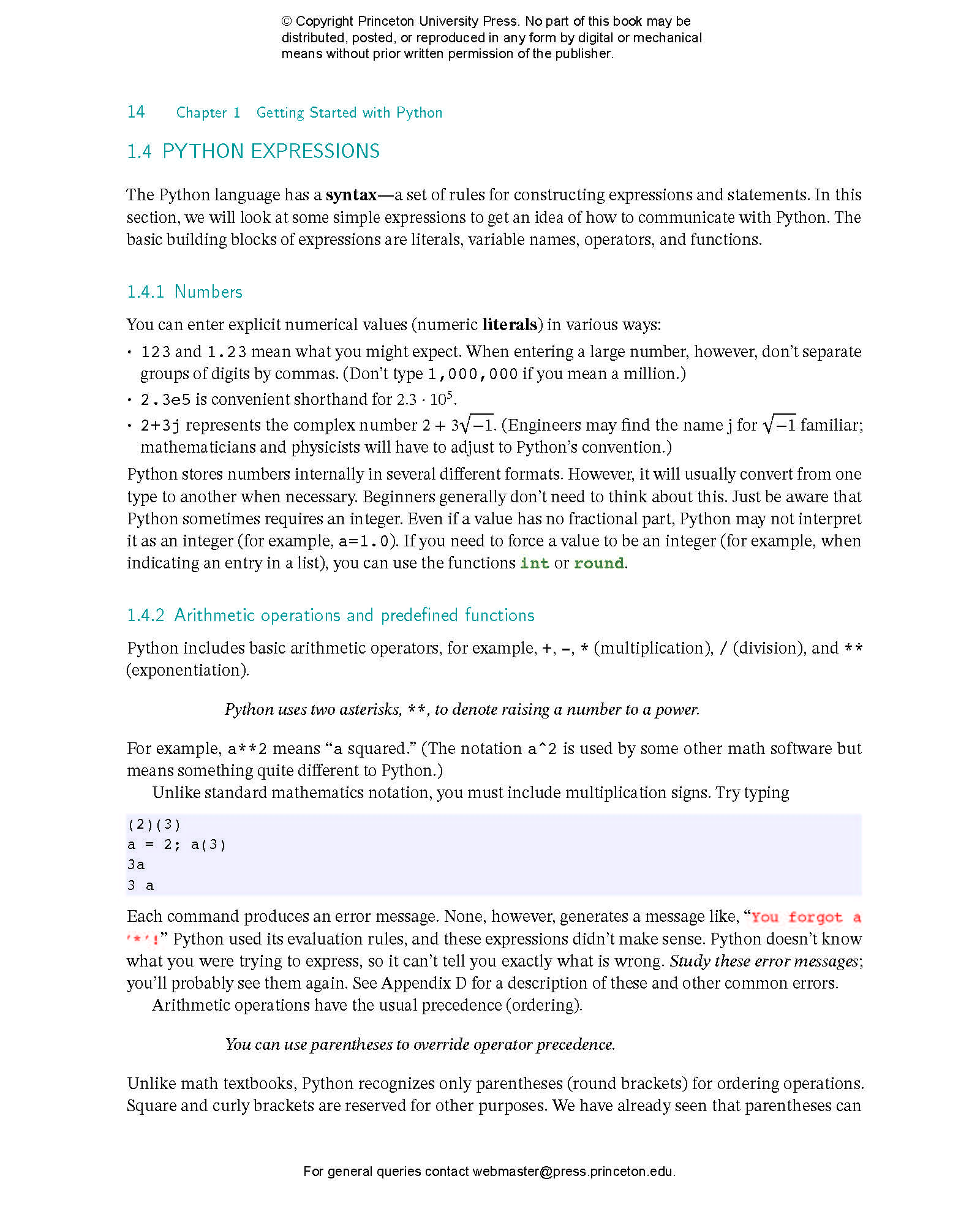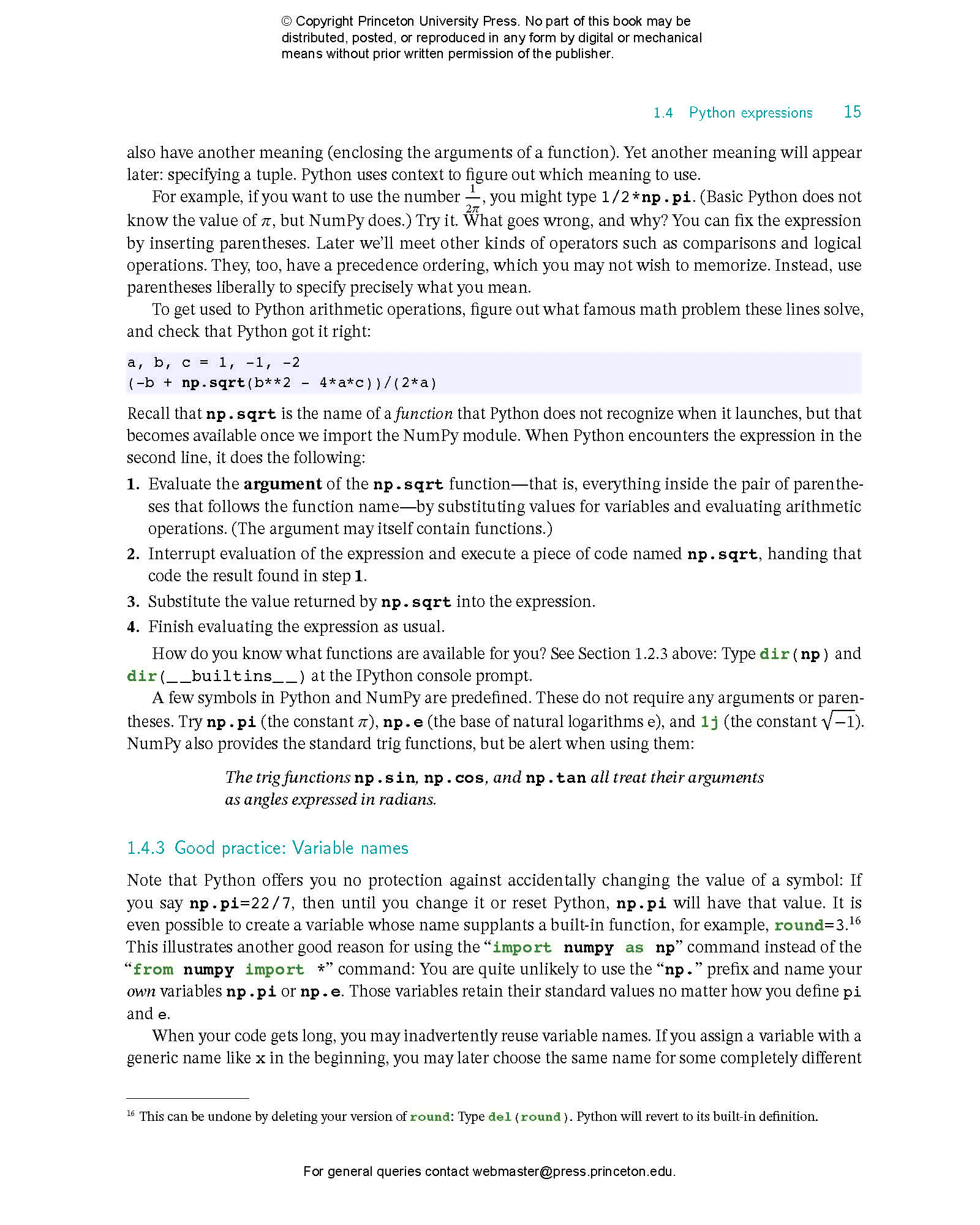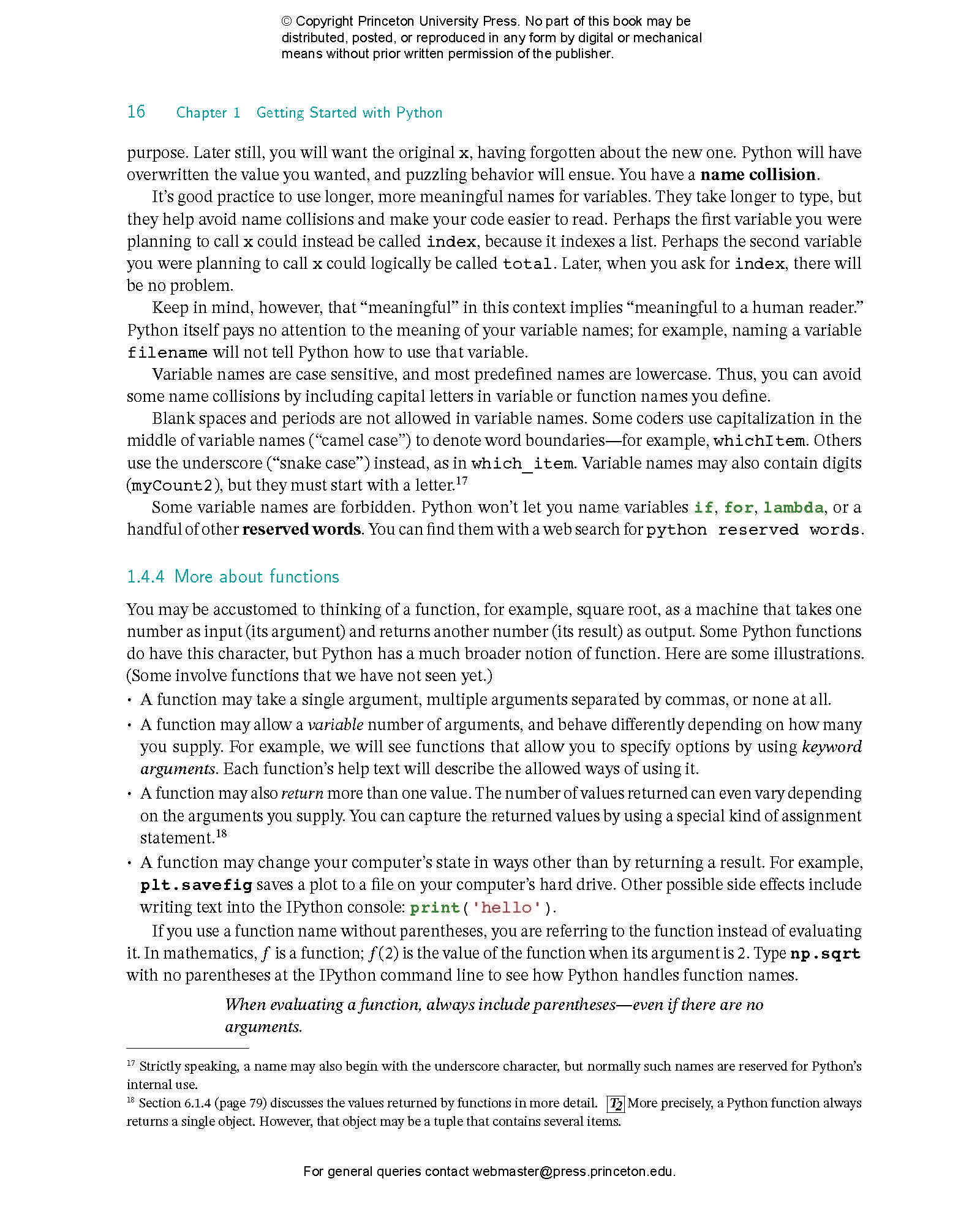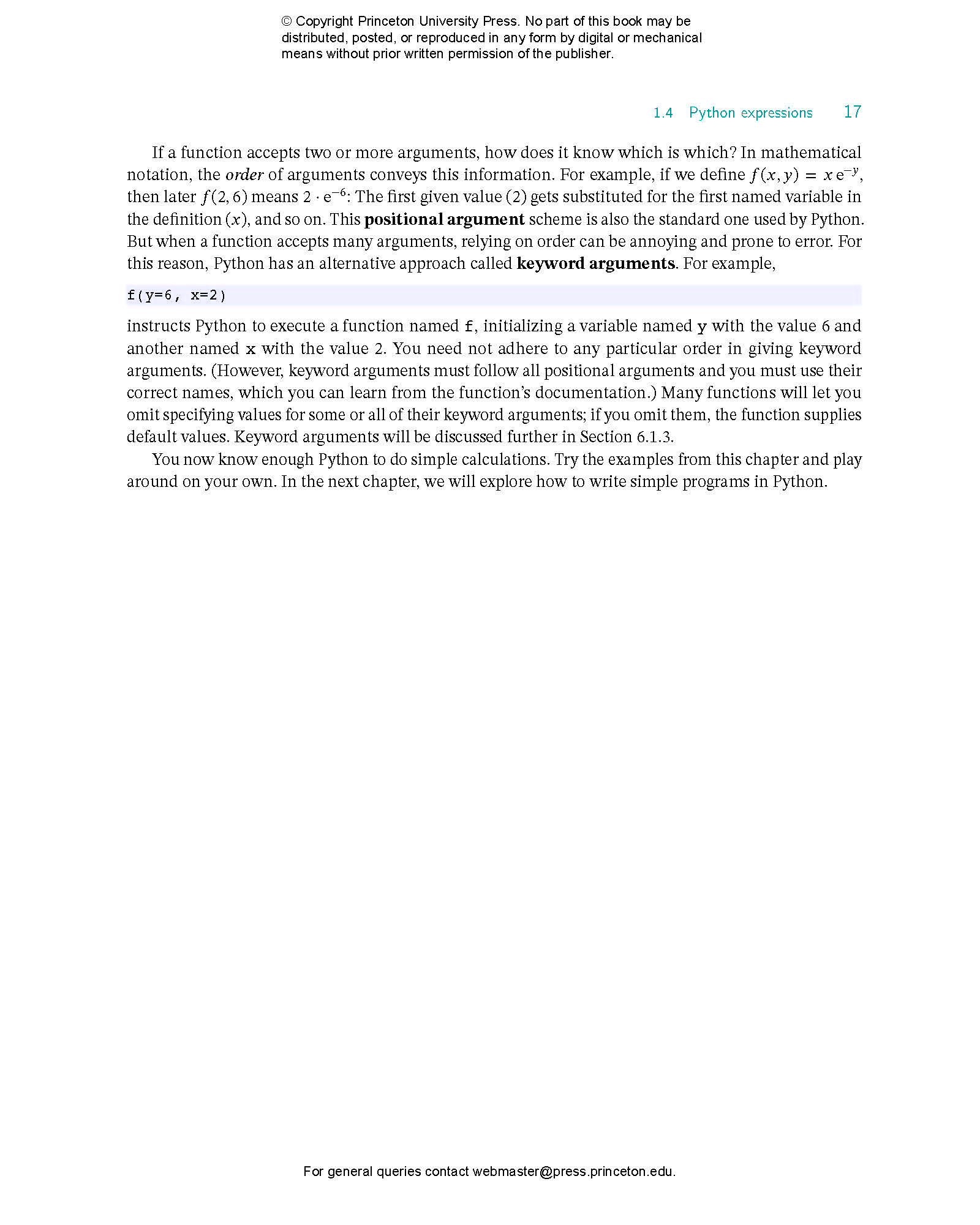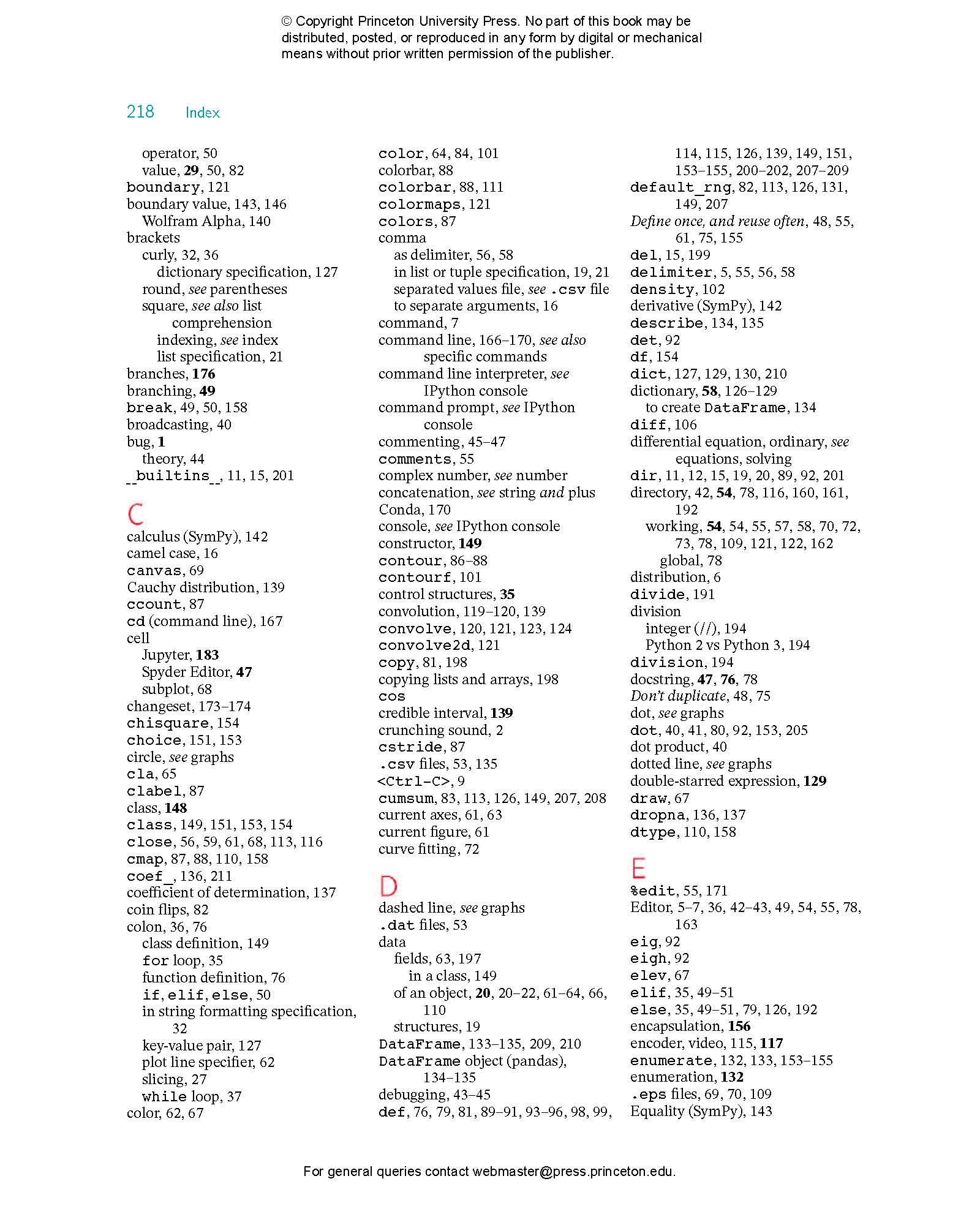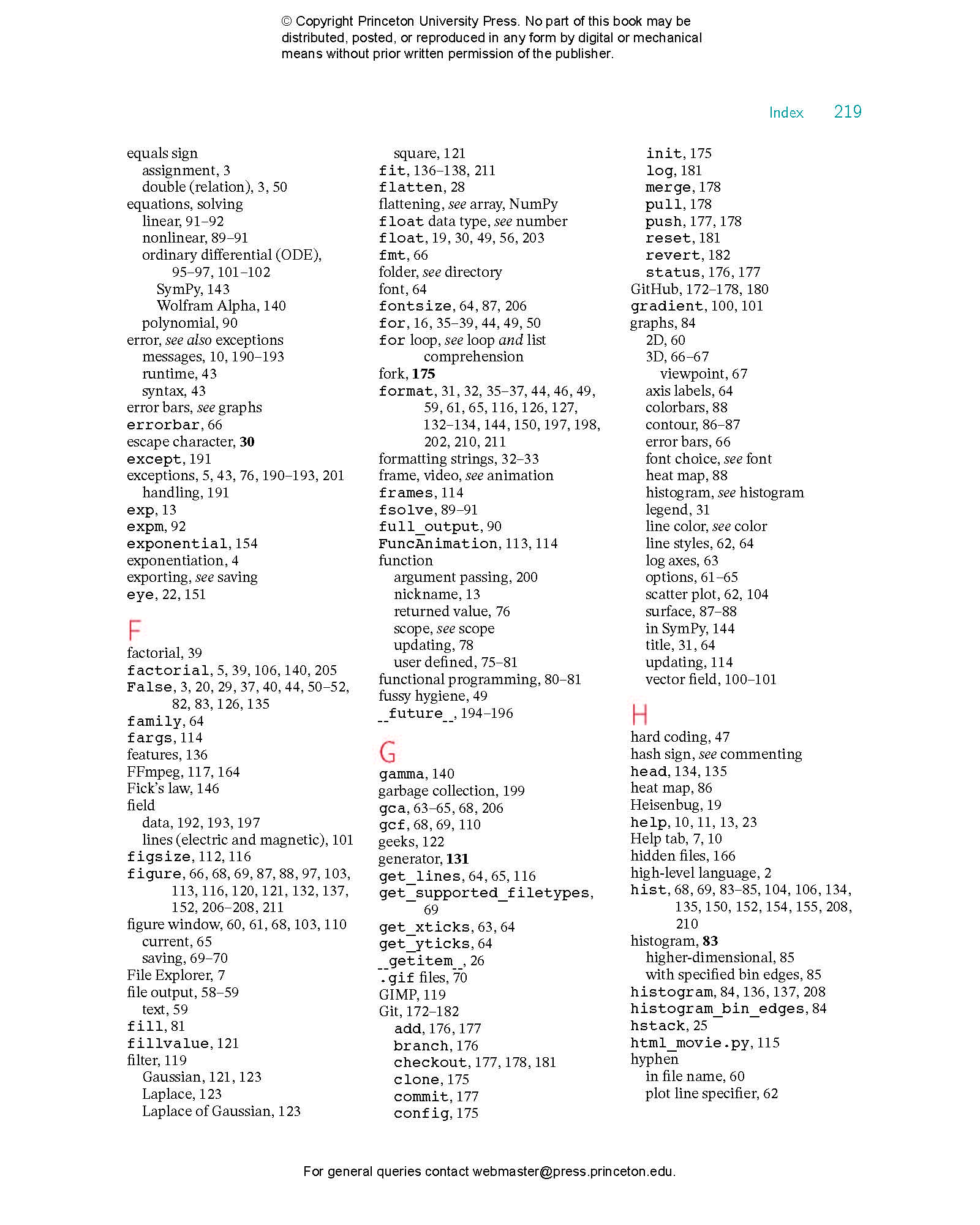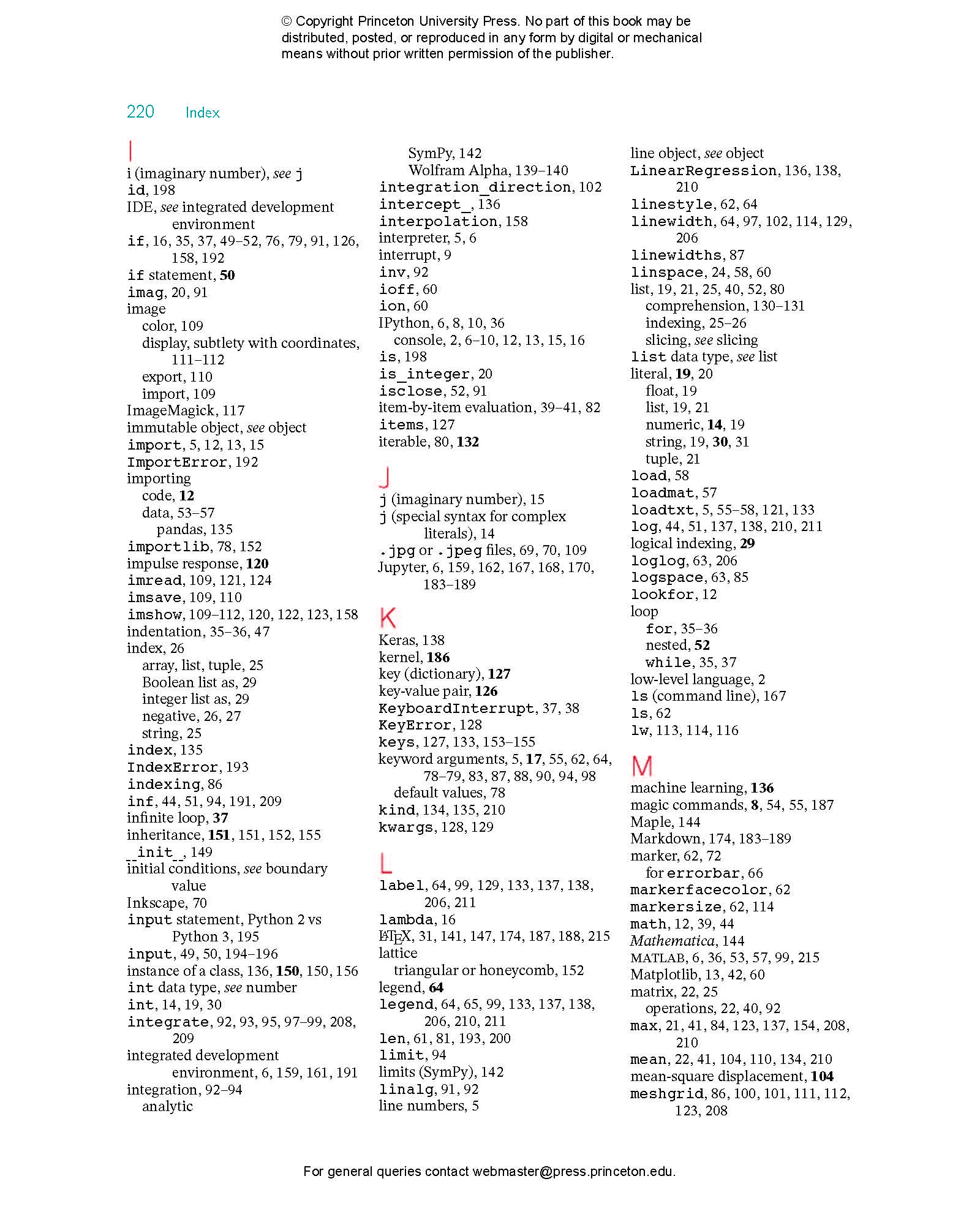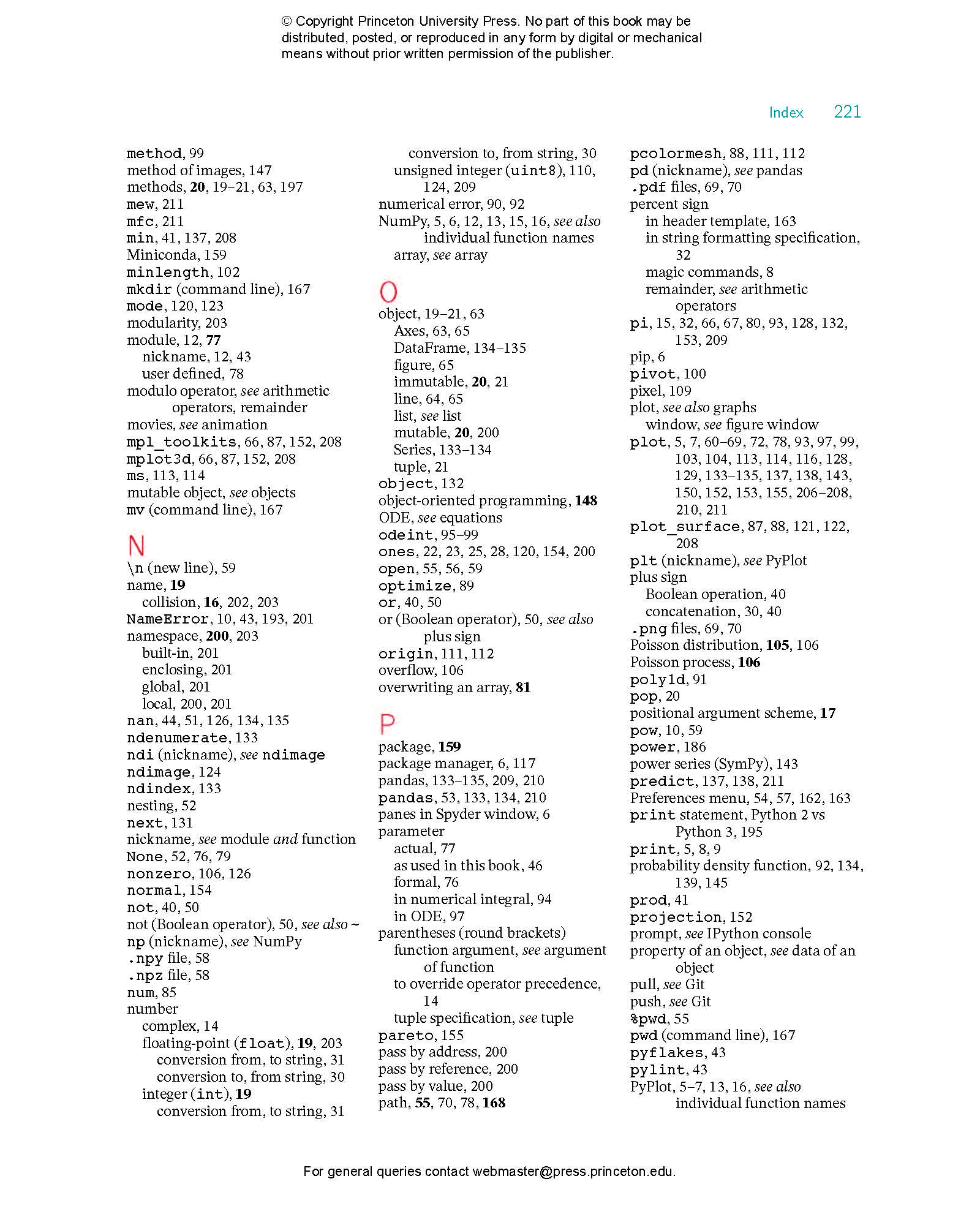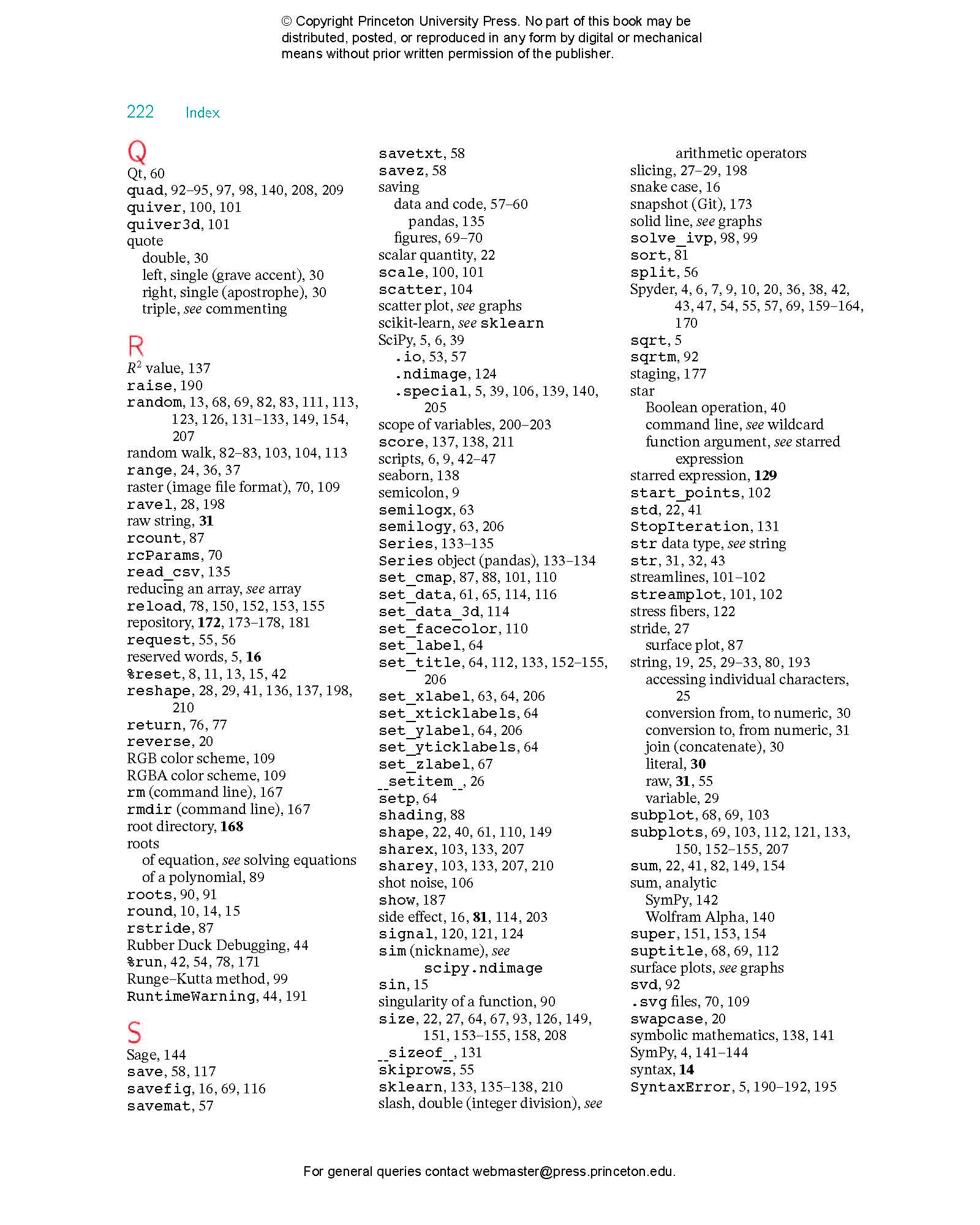Python is a computer programming language that has gained popularity throughout the sciences. This fully updated second edition of A Student’s Guide to Python for Physical Modeling aims to help you, the student, teach yourself enough of the Python programming language to get started with physical modeling. You will learn how to install an open-source Python programming environment and use it to accomplish many common scientific computing tasks: importing, exporting, and visualizing data; numerical analysis; and simulation. No prior programming experience is assumed.
This guide introduces a wide range of useful tools, including:
- Basic Python programming and scripting
- Numerical arrays
- Two- and three-dimensional graphics
- Animation
- Monte Carlo simulations
- Numerical methods, including solving ordinary differential equations
- Image processing
Numerous code samples and exercises—with solutions—illustrate new ideas as they are introduced. This guide also includes supplemental online resources: code samples, data sets, tutorials, and more. This edition includes new material on symbolic calculations with SymPy, an introduction to Python libraries for data science and machine learning (pandas and sklearn), and a primer on Python classes and object-oriented programming. A new appendix also introduces command line tools and version control with Git.
Jesse M. Kinder is associate professor of physics at the Oregon Institute of Technology. Philip Nelson is professor of physics at the University of Pennsylvania. His books include From Photon to Neuron (Princeton), Physical Models of Living Systems, and Biological Physics.
- Let’s Go
- 1 Getting Started with Python
- 1.1 Algorithms and algorithmic thinking
- 1.1.1 Algorithmic thinking
- 1.1.2 States
- 1.1.3 What does a = a + 1 mean?
- 1.1.4 Symbolic versus numerical
- 1.2 Launch Python
- 1.2.1 IPython console
- 1.2.2 Error messages
- 1.2.3 Sources of help
- 1.2.4 Good practice: Keep a log
- 1.3 Python modules
- 1.3.1 import
- 1.3.2 from … import
- 1.3.3 NumPy and PyPlot
- 1.4 Python expressions
- 1.4.1 Numbers
- 1.4.2 Arithmetic operations and predefined functions
- 1.4.3 Good practice: Variable names
- 1.4.4 More about functions
- 2 Organizing Data
- 2.1 Objects and their methods
- 2.2 Lists, tuples, and arrays
- 2.2.1 Creating a list or tuple
- 2.2.2 NumPy arrays
- 2.2.3 Filling an array with values
- 2.2.4 Concatenation of arrays
- 2.2.5 Accessing array elements
- 2.2.6 Arrays and assignments
- 2.2.7 Slicing
- 2.2.8 Flattening an array
- 2.2.9 Reshaping an array
- 2.2.10 T2 Lists and arrays as indices
- 2.3 Strings
- 2.3.1 Raw strings
- 2.3.2 Formatting strings with the format ( ) method
- 2.3.3 T2 Formatting strings with %
- 3 Structure and Control
- 3.1 Loops
- 3.1.1 for loops
- 3.1.2 while loops
- 3.1.3 Very long loops
- 3.1.4 Infinite loops
- 3.2 Array operations
- 3.2.1 Vectorizing math
- 3.2.2 Matrix math
- 3.2.3 Reducing an array
- 3.3 Scripts
- 3.3.1 The Editor
- 3.3.2 T2 Other editors
- 3.3.3 First steps to debugging
- 3.3.4 Good practice: Commenting
- 3.3.5 Good practice: Using named parameters
- 3.3.6 Good practice: Units
- 3.4 Contingent behavior: Branching
- 3.4.1 The if statement
- 3.4.2 Testing equality of floats
- 3.5 Nesting
- 4 Data In, Results Out
- 4.1 Importing data
- 4.1.1 Obtaining data
- 4.1.2 Bringing data into Python
- 4.2 Exporting data
- 4.2.1 Scripts
- 4.2.2 Data files
- 4.3 Visualizing data
- 4.3.1 The plot command and its relatives
- 4.3.2 Log axes
- 4.3.3 Manipulate and embellish
- 4.3.4 Replacing curves
- 4.3.5 T2 More about figures and their axes
- 4.3.6 T2 Error bars
- 4.3.7 3D graphs
- 4.3.8 Multiple plots
- 4.3.9 Subplots
- 4.3.10 Saving figures
- 4.3.11 T2 Using figures in other applications
- 5 First Computer Lab
- 5.1 HIV example
- 5.1.1 Explore the model
- 5.1.2 Fit experimental data
- 5.2 Bacterial example
- 5.2.1 Explore the model
- 5.2.2 Fit experimental data
- 6 Random Number Generation and Numerical Methods
- 6.1 Writing your own functions
- 6.1.1 Defining functions in Python
- 6.1.2 Updating functions
- 6.1.3 Arguments, keywords, and defaults
- 6.1.4 Return values
- 6.1.5 Functional programming
- 6.2 Random numbers and simulation
- 6.2.1 Simulating coin flips
- 6.2.2 Generating trajectories
- 6.3 Histograms and bar graphs
- 6.3.1 Creating histograms
- 6.3.2 Finer control
- 6.4 Contour plots, surface plots, and heat maps
- 6.4.1 Generating a grid of points
- 6.4.2 Contour plots
- 6.4.3 Surface plots
- 6.4.4 Heat maps
- 6.5 Numerical solution of nonlinear equations
- 6.5.1 General real functions
- 6.5.2 Complex roots of polynomials
- 6.6 Solving systems of linear equations
- 6.7 Numerical integration
- 6.7.1 Integrating a predefined function
- 6.7.2 Integrating your own function
- 6.7.3 Oscillatory integrands
- 6.7.4 T2 Parameter dependence
- 6.8 Numerical solution of differential equations
- 6.8.1 Reformulating the problem
- 6.8.2 Solving an ODE
- 6.8.2 T2 Parameter dependence
- 6.8.4 Other ODE solvers
- 6.9 Vector fields and streamlines
- 6.9.1 Vector fields
- 6.9.2 Streamlines
- 7 Second Computer Lab
- 7.1 Generating and plotting trajectories
- 7.2 Plotting the displacement distribution
- 7.3 Rare events
- 7.3.1 The Poisson distribution
- 7.3.2 Waiting times
- 8 Images and Animation
- 8.1 Image processing
- 8.1.1 Images as NumPy arrays
- 8.1.2 Saving and displaying images
- 8.1.3 Manipulating images
- 8.2 Displaying data as an image
- 8.3 Animation
- 8.3.1 Creating animations
- 8.3.2 Saving animations
- HTML movies
- T2 Using an encoder
- 8.3.3 Conclusion
- 9 Third Computer Lab
- 9.1 Convolution
- 9.1.1 Python tools for image processing
- 9.1.2 Averaging
- 9.1.3 Smoothing with a Gaussian
- 9.2 Denoising an image
- 9.3 Emphasizing features
- 9.4 T2 Image files and arrays
- 10 Advanced Techniques
- 10.1 Dictionaries and generators
- 10.1.1 Dictionaries
- 10.1.2 Special function arguments
- 10.1.3 List comprehensions and generators
- 10.2 Tools for data science
- 10.2.1 Series and data frames with pandas
- 10.2.2 Machine learning with scikit-learn
- 10.2.3 Next steps
- 10.3 Symbolic computing
- 10.3.1 Wolfram Alpha
- 10.3.2 The SymPy library
- 10.3.3 Other alternatives
- 10.3.4 First passage revisited
- 10.4 Writing your own classes
- 10.4.1 A random walk class
- 10.4.2 When to use classes
- Get Going
- A Installing Python
- A.1 Install Python and Spyder
- A.1.1 Graphical installation
- A.1.2 Command line installation
- A.2 Setting up Spyder
- A.2.1 Working directory
- A.2.2 Interactive graphics
- A.2.3 Script template
- A.2.4 Restart
- A.3 Keeping up to date
- A.4 Installing FFmpeg
- A.5 Installing ImageMagick
- B Command Line Tools
- B.1 The command line
- B.1.1 Navigating your file system
- B.1.2 Creating, renaming, moving, and removing files
- B.1.3 Creating and removing directories
- B.1.4 Python and Conda
- B.2 Text editors
- B.3 Version control
- B.3.1 How Git works
- B.3.2 Installing and using Git
- B.3.3 Tracking changes and synchronizing repositories
- B.3.4 Summary of useful workflows
- B.3.5 Troubleshooting
- B.4 Conclusion
- C Jupyter Notebooks
- C.1 Getting started
- C.1.1 Launch Jupyter Notebooks
- C.1.2 Open a notebook
- C.1.3 Multiple notebooks
- C.1.4 Quitting Jupyter
- C.1.5 T2 Setting the default directory
- C.2 Cells
- C.2.1 Code cells
- C.2.2 Graphics
- C.2.3 Markdown cells
- C.2.4 Edit mode and command mode
- C.3 Sharing
- C.4 More details
- C.5 Pros and cons
- D Errors and Error Messages
- D.1 Python errors in general
- D.2 Some common errors
- E Python 2 versus Python 3
- E.1 Division
- E.2 Print command
- E.3 User input
- E.4 More assistance
- F Under the Hood
- F.1 Assignment statements
- F.2 Memory management
- F.3 Functions
- F.4 Scope
- F.4.1 Name collisions
- F.4.2 Variables passed as arguments
- F.5 Summary
- G Answers to “Your Turn” Questions
- Acknowledgments
- Recommended Reading
- Index
Praise for the previous edition"At a brief 160 pages, it is quite possible for a motivated student to complete it in just a few sittings. . . . A fine introduction." —American Journal of Physics
"The text serves as an excellent stepping stone into the world of using Python in computational science for undergraduate students with a strong background in mathematics."—Kevin Thielen and Vivienne Tien, Computing in Science & Engineering
"Kinder and Nelson's engaging introduction to scientific programming in Python is careful and thorough, and focuses on actual essentials. Bread-and-butter concepts and techniques, belonging in every computational scientist's toolbox, are presented with well-thought-out examples drawn from daily research practice. This is a clever text, inviting students to take that most important step: to dive right in and start coding."—Cornelis Storm, Eindhoven University of Technology
"Kinder and Nelson have written a friendly and succinct, yet surprisingly comprehensive, introduction to scientific programming in Python. It's written not just for computational scientists, but for anyone who needs to plot and analyze experimental data, numerically solve equations, or learn the basics of programming. Even students who have experience in programming will appreciate the thought-provoking exercises and guidelines for getting the most out of Python."—Vinothan N. Manoharan, Harvard University
"This book is tailor-made for physical scientists beginning to do computation. More than in any other programming book I've read, the authors are conscientious—they anticipate and troubleshoot the areas of confusion readers might encounter. Kinder and Nelson carefully and effectively guide readers toward the goal of formulating a computational problem and solving it."—Justin Bois, California Institute of Technology
"Like patient driving instructors, Kinder and Nelson guide the hands of novice programming students from the get-go, helping them to avoid obstacles and crashes. By the end of the book, students should be racing around confidently like pros, using Python to solve scientific problems of data analysis, modeling, and visualization. A great textbook for a first course in modern scientific programming in any context, and one that I'll be using myself."—Garnet Kin-Lic Chan, Princeton University
"This book covers the basics of Python programming language, with an emphasis on physical modeling. It provides a very useful introduction to Python for undergraduate students and others who have never programmed before."—Željko Ivezić , University of Washington
"This is an excellent introductory text, aimed at those with little to no experience in programming. In a clear and concise manner, the authors cover or touch upon all the important aspects of computational science in Python. They guide readers by explaining how to best perform certain common tasks in scientific computing. The book's examples and user exercises are well selected."—Quentin Caudron, Princeton University
